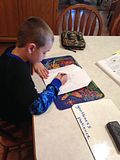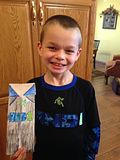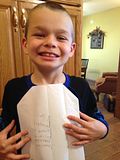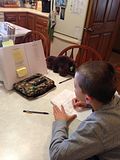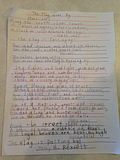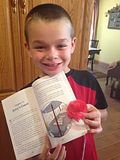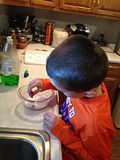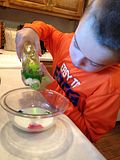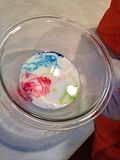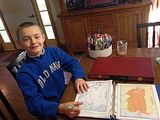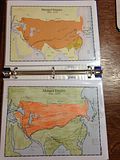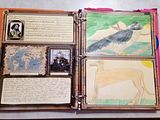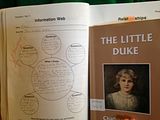World History High School
Wyatt finished his first art project this week for his Fine Arts half credit. We both were so pleased!

Pat Knepley is such a positive Christian lady, and she gives excellent cueing on her DVDs for each step of the art project. The first composition was "Tiffany Window," and it had Wyatt using the stained glass window effect. He read about and answered questions about Leonardo daVinci in his "Short Lessons in Art History" book, learning that daVinci was apprenticed in Italy to the artist Verrocchio. Labeling daVinci's beautiful full color paintings of "The Mona Lisa," "Virgin of the Rocks," "The Annunciation," and other paintings as well in HOD's Art Notebook brought on much discussion of his realistic style of painting. Wyatt found it so sad that Leonardo left incomplete paintings, as well as how few original paintings of his have been found. Here Wyatt is with his "Tiffany Window."

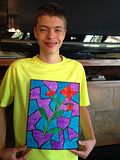
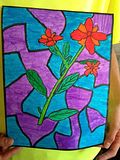
In World History, Wyatt prepared his "Talking Points" about the section entitled
Sticks, Terraces, Urns, and Gardens from "People Places, and Events of World History." I cannot help but think how useful activities like these would have been prior to my taking speech in college. I actually liked speech in college, and went on to be a paid instructor for the college to teach speech to a small group of students for several semesters. I really enjoyed it! But, many of the students had little or no experience preparing to give a speech. This type of activity, which involves taking bulleted notes on an index card and sharing talking points with an adult in the form of an oral narration teaches excellent skills for 'speech' classes which are coming in the near future.

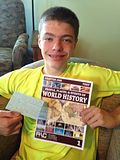
Wyatt is nearing the end of his Literature Study classic "Ben Hur." The parallels to Scripture/events/people in the Bible that HOD draws out have provided so many solid connections. I love that Christ is kept at the center of my ds's high school education - even in reading classic literature - which can be difficult!

Wyatt's Common Place Book continues be filled with memorable quotes. I like that he is learning more and more to watch for foreshadowing and allusions, and annotating is something I commonly do when reading that I also like he is learning to do - definitely grown up, higher level skills that are possible to teach because of the firm foundation he had earlier with all of his previous years in HOD's DITHOR.
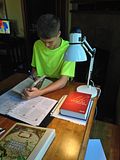
In Geometry, Wyatt is learning to write proofs using various axioms such as SAS, ASA, SSS, and the isosceles triangle theorem. I'm a little rusty on all of this, having had my last Geometry class about 20+ years ago (yes, I took Geometry when I was 10 yo

- ha, just kidding - showing my age here). Anyway, I am using this checkoff as I go, as it helps me keep track of what I want to grade and what I just want to partner with him on and check off. (The grading scale is the one from the WG Introduction.) It is going well, and it is definitely 'hard enough.'

I don't leave his side often during math, lest I be left in the dust and unable to help.

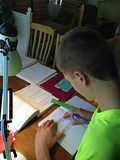
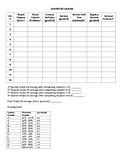
For the Living Library, Wyatt finish his
Literary Synthesis Sheet for "The Hero Schliemann." He LOVED this book! He got a big kick out of the wit and somewhat absurd lengths Schliemann would go to be 'famous.' The main character, Schliemann, is quirky, brilliant, shady - there are many adjectives that would describe him - not all honorable, but most intriguing. He had a knack for learning foreign languages - 22 in total I believe. He learned Arabic just to read "Arabian Nights" in Arabic - what other language would it possibly be right to read it in, according to Schliemann?!?

The
Word and Idea Helper sheet is helping Wyatt expand his vocabulary and add even more depth to his answers. This time, I had him highlight the words he used, so I could easily find them in his analysis of the book. We are loving the Living Library!
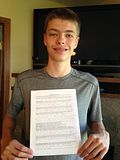
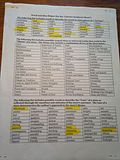
Wyatt's World History written narration was in response to his reading about various forms of transportation through history. His critical thinking question from "Short Lessons in World History" went with it perfectly, as it was in regard to the Minoan civilization on the island of Crete and its navy fleet that sailed across the Mediterranean Sea. These critical thinking questions have been an excellent way for Wyatt to develop the skill of answering questions in a thorough, supported, accurate way. As answering higher level questions completely and knowledgeably is one of the primary measures of success both in showing comprehension in graduate coursework as well as in displaying proficiency in being considered for future job opportunities, I am glad he is learning this now. Being able to communicate well in writing (and speaking) is a skill that is needed in virtually every career in some way if a person is hoping to advance in position during employment.

Looking ahead to a future where he can provide for his family well enough that his wife can stay home and homeschool is a goal of his, so I take teaching writing skills seriously.



In Christ,
Julie











